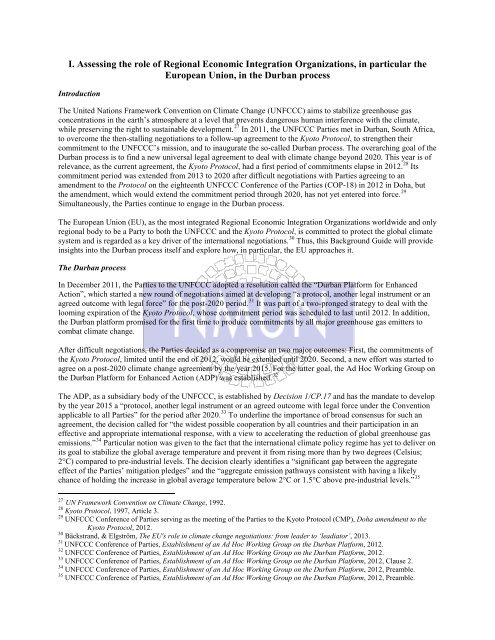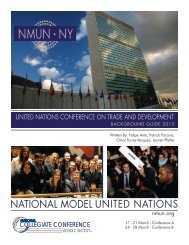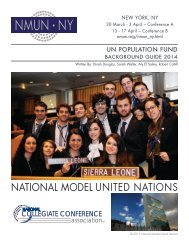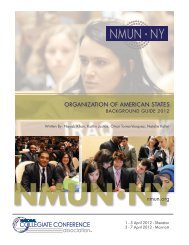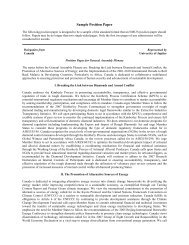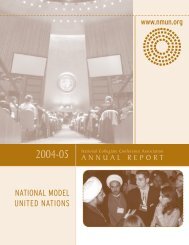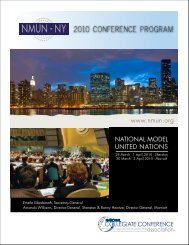NMUN • KOREA - National Model United Nations
NMUN • KOREA - National Model United Nations
NMUN • KOREA - National Model United Nations
You also want an ePaper? Increase the reach of your titles
YUMPU automatically turns print PDFs into web optimized ePapers that Google loves.
I. Assessing the role of Regional Economic Integration Organizations, in particular the<br />
European Union, in the Durban process<br />
Introduction<br />
The <strong>United</strong> <strong>Nations</strong> Framework Convention on Climate Change (UNFCCC) aims to stabilize greenhouse gas<br />
concentrations in the earth’s atmosphere at a level that prevents dangerous human interference with the climate,<br />
while preserving the right to sustainable development. 27 In 2011, the UNFCCC Parties met in Durban, South Africa,<br />
to overcome the then-stalling negotiations to a follow-up agreement to the Kyoto Protocol, to strengthen their<br />
commitment to the UNFCCC’s mission, and to inaugurate the so-called Durban process. The overarching goal of the<br />
Durban process is to find a new universal legal agreement to deal with climate change beyond 2020. This year is of<br />
relevance, as the current agreement, the Kyoto Protocol, had a first period of commitments elapse in 2012. 28 Its<br />
commitment period was extended from 2013 to 2020 after difficult negotiations with Parties agreeing to an<br />
amendment to the Protocol on the eighteenth UNFCCC Conference of the Parties (COP-18) in 2012 in Doha, but<br />
the amendment, which would extend the commitment period through 2020, has not yet entered into force. 29<br />
Simultaneously, the Parties continue to engage in the Durban process.<br />
The European Union (EU), as the most integrated Regional Economic Integration Organizations worldwide and only<br />
regional body to be a Party to both the UNFCCC and the Kyoto Protocol, is committed to protect the global climate<br />
system and is regarded as a key driver of the international negotiations. 30 Thus, this Background Guide will provide<br />
insights into the Durban process itself and explore how, in particular, the EU approaches it.<br />
The Durban process<br />
In December 2011, the Parties to the UNFCCC adopted a resolution called the “Durban Platform for Enhanced<br />
Action”, which started a new round of negotiations aimed at developing “a protocol, another legal instrument or an<br />
agreed outcome with legal force” for the post-2020 period. 31 It was part of a two-pronged strategy to deal with the<br />
looming expiration of the Kyoto Protocol, whose commitment period was scheduled to last until 2012. In addition,<br />
the Durban platform promised for the first time to produce commitments by all major greenhouse gas emitters to<br />
combat climate change.<br />
After difficult negotiations, the Parties decided as a compromise on two major outcomes: First, the commitments of<br />
the Kyoto Protocol, limited until the end of 2012, would be extended until 2020. Second, a new effort was started to<br />
agree on a post-2020 climate change agreement by the year 2015. For the latter goal, the Ad Hoc Working Group on<br />
the Durban Platform for Enhanced Action (ADP) was established. 32<br />
The ADP, as a subsidiary body of the UNFCCC, is established by Decision 1/CP.17 and has the mandate to develop<br />
by the year 2015 a “protocol, another legal instrument or an agreed outcome with legal force under the Convention<br />
applicable to all Parties” for the period after 2020. 33 To underline the importance of broad consensus for such an<br />
agreement, the decision called for “the widest possible cooperation by all countries and their participation in an<br />
effective and appropriate international response, with a view to accelerating the reduction of global greenhouse gas<br />
emissions.” 34 Particular notion was given to the fact that the international climate policy regime has yet to deliver on<br />
its goal to stabilize the global average temperature and prevent it from rising more than by two degrees (Celsius;<br />
2°C) compared to pre-industrial levels. The decision clearly identifies a “significant gap between the aggregate<br />
effect of the Parties’ mitigation pledges” and the “aggregate emission pathways consistent with having a likely<br />
chance of holding the increase in global average temperature below 2°C or 1.5°C above pre-industrial levels.” 35<br />
27<br />
UN Framework Convention on Climate Change, 1992.<br />
28 Kyoto Protocol, 1997, Article 3.<br />
29 UNFCCC Conference of Parties serving as the meeting of the Parties to the Kyoto Protocol (CMP), Doha amendment to the<br />
Kyoto Protocol, 2012.<br />
30 Bäckstrand, & Elgström, The EU's role in climate change negotiations: from leader to ‘leadiator’, 2013.<br />
31<br />
UNFCCC Conference of Parties, Establishment of an Ad Hoc Working Group on the Durban Platform, 2012.<br />
32 UNFCCC Conference of Parties, Establishment of an Ad Hoc Working Group on the Durban Platform, 2012.<br />
33 UNFCCC Conference of Parties, Establishment of an Ad Hoc Working Group on the Durban Platform, 2012, Clause 2.<br />
34 UNFCCC Conference of Parties, Establishment of an Ad Hoc Working Group on the Durban Platform, 2012, Preamble.<br />
35 UNFCCC Conference of Parties, Establishment of an Ad Hoc Working Group on the Durban Platform, 2012, Preamble.


